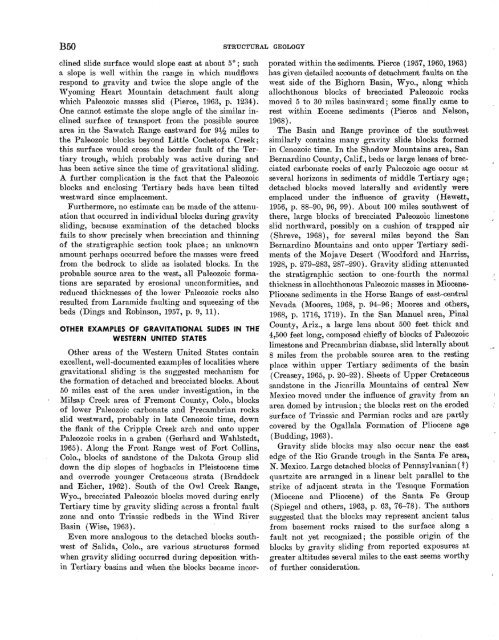RESEARCH· ·1970·
RESEARCH· ·1970·
RESEARCH· ·1970·
Create successful ePaper yourself
Turn your PDF publications into a flip-book with our unique Google optimized e-Paper software.
B50<br />
STRUCTURAL GEOLOGY<br />
clined slide surface would slope east at about 5o ; such<br />
a slope is well within the range in which mudflows<br />
respond to gravity and twice the slope angle of the<br />
Wyoming Heart ~fountain detachment fault along<br />
which Paleozoic masses slid (Pierce, 1963, p. 1234).<br />
One cannot estimate the slope angle of the similar inclined<br />
surface of transport from the possible source<br />
area in the Sa watch Range eastward for 91h miles to<br />
the Paleozoic blocks beyond Little Cochetopa Creek;<br />
this surface would cross the border fault of the Tertiary<br />
trough, which probably was active during and<br />
has been active since the time of gravitational sliding.<br />
A further complication is the fact that the Paleozoic<br />
blocks and enclosing Tertiary beds have been tilted<br />
westward since emplacement.<br />
Furthermore, no estimate can be made of the attenuation<br />
that occurred in individual blocks during gravity<br />
sliding, because examination of the detached blocks<br />
fails to show precisely when brecciation and thinning<br />
of the stratigraphic section took place; an unknown<br />
amount perhaps occurred before the masses were freed<br />
from the bedrock to slide as isolated blocks. In the<br />
probable source area to the west, all Paleozoic formations<br />
are separated by erosional unconformities, and<br />
reduced thicknesses of the lower Paleozoic rocks also<br />
resulted from Laramide faulting and squeezing of the<br />
beds (Dings and Robinson, 1957, p. 9, 11).<br />
OTHER EXAMPLES OF GRAVITATIONAL SLID·ES IN THE'<br />
WESTERN UNfTED S;TATES<br />
Other areas of the "r estern United States contain<br />
excellent, well-documented examples of localities where<br />
gravitational sliding is the suggested mechanism for<br />
the formation of detached and brecciated blocks. About<br />
50 miles east of the area under investigation, in the<br />
~filsap Creek area of Fremont County, Colo., blocks<br />
of lower Paleozoic carbonate and Precambrian rocks<br />
slid westward, probably in late Cenozoic time, down<br />
the flank of the Cripple Creek arch and onto upper<br />
Paleozoic rocks in a graben (Gerhard and 'V ahlstedt,<br />
1965). Along the Front Range west of Fort Collins,<br />
Colo., blocks of sandstone of the Dakota Group slid<br />
down the dip slopes of hogbacks in Pleistocene time<br />
and overrode younger Cretaceous strata (Braddock<br />
and Eicher, 1962). South of the Owl Creek Range,<br />
Wyo., brecciated Paleozoic blocks moved during early<br />
Tertiary time by gravity sliding across a frontal fault<br />
zone and onto Triassic redbeds in the vVind River<br />
Basin (Wise, 1963).<br />
Even more analogous to the detached blocks southwest<br />
of Salida, Colo., are various structures formed<br />
when gravity sliding occurred during deposition within<br />
Tertiary basins rund when the blocks beca1ne incorporated<br />
within the sediments. Pierce ( 1957, 1960, 1963)<br />
has given detailed accounts of detJaohmem.lt faults on the<br />
west side of the Bighorn Basin, 'Vyo., along which<br />
allochthonous blocks of brecciated Paleozoic rocks<br />
moved 5 to 30 miles basin ward; some finally came to<br />
rest within Eocene sediments (Pierce and Nelson,<br />
1968).<br />
The Basin and Range province of the southwest<br />
similarly contains many gravity slide blocks formed<br />
in Cenozoic time. In the Shadow ~fountains area, San<br />
Bernardino County, Calif., beds or large lenses of brecciated<br />
carbonate rocks of early Paleozoic age occur ·at<br />
several horizons in sediments of middle Tertiary age;<br />
detached blocks moved laterally and evidently were<br />
emplaced under the influence of gravity (Hewett,<br />
1956, p. 88-90, 96, 99). About 100 miles southwest of<br />
there, large blocks of brecciated Paleozoic limestone<br />
slid northward, possibly on a cushion of trapped air<br />
(Shreve, 1968), for several miles beyond the San<br />
Bernardino ~fountains and onto upper Tertiary sediments<br />
of the ~fojave Desert ('iVoodford and Harriss,<br />
1928, p. 279-283, 287-290). Gravity sliding attenuated<br />
the stratigraphic section to one-fourth the normal<br />
thickness in allochthonous Paleozoic masses in Miocene<br />
Pliocene sediments in ·the Horse Range of east-central<br />
Nevada (~foores, 1968, p. 94-96; ~1oores and others,<br />
1968, p. 1716, 1719). In the San ~fanuel area, Pinal<br />
County, Ariz., a large lens about 500 feet thick and<br />
4,500 feet long, cmnposed chiefly of blocks of Paleozoic<br />
limestone and Precambrian diabase, slid laterally about<br />
8 miles from the probable source area to the resting<br />
place within upper Tertiary sediments of the basin<br />
(Creasey, 1965, p. 20-22). Sheets of Upper Cretaceous<br />
sandstone in the Jicarilla ~fountains of central New<br />
J\fexico moved under the influence of gravity from an<br />
area domed by intrusion; the blocks rest on the eroded<br />
s·urface of Triassic and Permian rocks and are partly<br />
covered by the Ogallala Formation of Pliocene age<br />
(Budding, 1963).<br />
Gravity slide blocks may also occur near the east<br />
edge of the Rio Grande trml.gh in the Santa Fe area,<br />
N. Mexico. Large detached blocks of Pennsylvanian(~)<br />
quartzite are arranged in a linear belt parallel to the<br />
strike of adjacent strata in the Tesuque Formation<br />
(~1iocene and Pliocene) of the Santa Fe Group<br />
(Spiegel and others, 1963, p. 63, 76-78). The authors<br />
suggested that the blocks may represent ancient talus<br />
from basement rocks raised to the surface along a<br />
fault not yet recognized; the possible origin of the<br />
blocks by gravity sliding from reported exposures at<br />
greater altitudes several miles to the east seems worthy<br />
of further consideration.
















